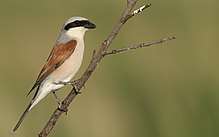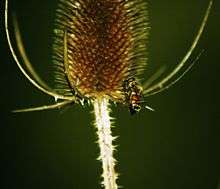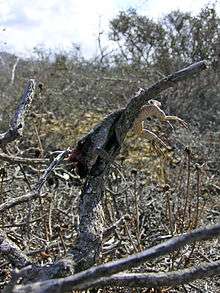Shrike
Shrikes (/ʃraɪk/) are carnivorous passerine birds of the family Laniidae. The family is composed of 33 species in four genera.
| Shrikes | |
|---|---|
 | |
| Red-backed shrike (Lanius collurio) | |
| Scientific classification | |
| Kingdom: | Animalia |
| Phylum: | Chordata |
| Class: | Aves |
| Order: | Passeriformes |
| Superfamily: | Corvoidea |
| Family: | Laniidae Rafinesque, 1815 |
| Genera | |
| |
The family name, and that of the largest genus, Lanius, is derived from the Latin word for "butcher", and some shrikes are also known as butcherbirds because of their feeding habits.[1] The common English name shrike is from Old English scrīc, alluding to the shrike's shriek-like call.[2]
Distribution, migration, and habitat
Most shrike species have a Eurasian and African distribution, with just two breeding in North America (the loggerhead and northern shrikes). No members of this family occur in South America or Australia, although one species reaches New Guinea. The shrikes vary in the extent of their ranges, with some species such as the great grey shrike ranging across the Northern Hemisphere to the Newton's fiscal which is restricted to the island of São Tomé.[3]
They inhabit open habitats, especially steppe and savannah. A few species of shrikes are forest dwellers, seldom occurring in open habitats. Some species breed in northern latitudes during the summer, then migrate to warmer climes for the winter.
Description
Shrikes are medium-sized birds with grey, brown, or black and white plumage. Most species are between 16 cm (6.3 in) and 25 cm (9.8 in) in size, however, the genus Corvinella with its extremely elongated tail feathers may reach up to 50 cm (20 in) in length. Their beaks are hooked, like those of a bird of prey, reflecting their predatory nature, and their calls are strident.
Behaviour

Shrikes are known for their habit of catching insects and small vertebrates and impaling their bodies on thorns, the spikes on barbed-wire fences, or any available sharp point. This helps them to tear the flesh into smaller, more conveniently sized fragments, and serves as a cache so that the shrike can return to the uneaten portions at a later time.[4] This same behaviour of impaling insects serves as an adaptation to eating the toxic lubber grasshopper, Romalea microptera. The bird waits for 1–2 days for the toxins within the grasshopper to degrade, when they can then eat it.[5]
Loggerhead Shrikes kill vertebrates by using their beaks to grab the neck and violently shake their prey.[6]
Shrikes are territorial, and these territories are defended from other pairs. In migratory species, a breeding territory is defended in the breeding grounds and a smaller feeding territory is established during migration and in the wintering grounds.[3] Where several species of shrikes exist together, competition for territories can be intense.
Shrikes make regular use of exposed perch sites, where they adopt a conspicuous upright stance. These sites are used to watch for prey and to advertise their presence to rivals.
Breeding
Shrikes are generally monogamous breeders, although polygyny has been recorded in some species.[3] Co-operative breeding, where younger birds help their parents raise the next generation of young, has been recorded in both species in the genera Eurocephalus and Corvinella, as well as one species of Lanius. Males attract females to their territory with well-stocked caches, which may include inedible but brightly coloured items. During courtship, the male performs a ritualised dance which includes actions that mimic the skewering of prey on thorns, and feeds the female. Shrikes make simple, cup-shaped nests from twigs and grasses, in bushes and the lower branches of trees.[4]
Species in taxonomic order

The family Laniidae was introduced (as Lanidia) by the French polymath Constantine Samuel Rafinesque in 1815.[7][8]
FAMILY: LANIIDAE[9]
- Genus: Lanius
- Tiger shrike, Lanius tigrinus
- Souza's shrike, Lanius souzae
- Bull-headed shrike, Lanius bucephalus
- Brown shrike, Lanius cristatus
- Red-backed shrike, Lanius collurio
- Isabelline shrike, Lanius isabellinus
- Red-tailed shrike, Lanius phoenicuroides
- Burmese shrike, Lanius collurioides
- Emin's shrike, Lanius gubernator
- Bay-backed shrike, Lanius vittatus
- Long-tailed shrike, Lanius schach
- Grey-backed shrike, Lanius tephronotus
- Mountain shrike or grey-capped shrike, Lanius validirostris
- Mackinnon's shrike, Lanius mackinnoni
- Lesser grey shrike, Lanius minor
- Loggerhead shrike, Lanius ludovicianus
- Northern shrike, Lanius borealis
- Great grey shrike or northern shrike, Lanius excubitor
- Steppe grey shrike, Lanius excubitor pallidirostris
- Iberian grey shrike, Lanius meridionalis
- Chinese grey shrike, Lanius sphenocercus
- Grey-backed fiscal, Lanius excubitoroides
- Long-tailed fiscal, Lanius cabanisi
- Taita fiscal, Lanius dorsalis
- Somali fiscal, Lanius somalicus
- Northern fiscal, Lanius humeralis
- Southern fiscal, Lanius collaris
- Uhehe fiscal, Lanius collaris marwitzi
- São Tomé fiscal, Lanius newtoni
- Woodchat shrike, Lanius senator
- Masked shrike, Lanius nubicus
- Genus: Corvinella
- Yellow-billed shrike, Corvinella corvina
- Genus: Urolestes
- Magpie shrike, Urolestes melanoleucus
- Genus: Eurocephalus
- Northern white-crowned shrike, Eurocephalus ruppelli
- Southern white-crowned shrike, Eurocephalus anguitimens
Birds with similar names
Other species with names including the word shrike, due to perceived similarities in morphology, are in the families:
- Vangidae, vangas, helmetshrikes, woodshrikes, flycatcher-shrikes, shrike-flycatchers and philentomas
- Malaconotidae, bushshrikes, puffbacks, tchagras and boubous
- Campephagidae, cuckooshrikes, trillers and cicadabirds
- Falcunculidae, shriketits
- Pachycephalidae, whistlers and shrikethrushes
- Platylophidae, the crested shrikejay
- Vireonidae, vireos, including Cyclarhis peppershrikes, Vireolanius shrike-vireos and Pteruthius shrike-babblers
- Platysteiridae, wattle-eyes and batises, including the white-tailed shrike
- Thraupidae, tanagers, including the shrike-like tanager and Lanio shrike-tanagers
- Monarchidae, monarchs, including Clytorhynchus shrikebills
- Thamnophilidae, antbirds, antshrikes, antwrens and antvireos
- Tyrannidae tyrant flycatchers, including Agriornis shrike-tyrants
- Tityridae, becards and allies, including Laniisoma shrike-like cotingas
The helmetshrikes and bushshrikes were formerly included in Laniidae, but they are now known to be not particularly closely related to true shrikes.
The Australasian butcherbirds are not shrikes, although they occupy a similar ecological niche.
In fiction
In Michael Connelly's 2020 novel, Fair Warning, a serial killer is named "The Shrike" because he snaps the necks of his victims.[10]
In the science fiction novel Hyperion, by Dan Simmons, the central antagonist is a strange creature, perhaps cybernetic and futuristic in origin, that has the ability to appear in any area of space and time, kidnapping seemingly random individuals. These victims are later seen impaled on an impossibly large metal tree of thorns, agonized eternally. This gives the entity a quality not unlike this bird, although it does not consume its victims for sustenance. The entity is referred to simply as The Shrike.
In the short story "The Lesser Evil" by Andrzej Sapkowski, from his The Witcher series, the suspected monster Renfri is called Shrike due to her alleged habit of impaling living people on poles.
References
- Jobling, James A (2010). The Helm Dictionary of Scientific Bird Names. London: Christopher Helm. p. 219. ISBN 978-1-4081-2501-4.
- "Shrike". Oxford English Dictionary (3rd ed.). Oxford University Press. September 2005. (Subscription or UK public library membership required.)
- Yosef, Reuven (2008). "Family Laniidae (Shrikes)". In Josep, del Hoyo; Andrew, Elliott; David, Christie (eds.). Handbook of the Birds of the World. Volume 13, Penduline-tits to Shrikes. Barcelona: Lynx Edicions. pp. 732–773. ISBN 978-84-96553-45-3.
- Clancey, P.A. (1991). Forshaw, Joseph (ed.). Encyclopaedia of Animals: Birds. London: Merehurst Press. p. 180. ISBN 1-85391-186-0.
- Yosef, Reuven; Whitman, Douglas W. (1992). "Predator exaptations and defensive adaptations in evolutionary balance: No defence is perfect". Evolutionary Ecology. 6 (6): 527–536. doi:10.1007/BF02270696.
- Sustaita, Diego; Rubega, Margaret A.; Farabaugh, Susan M. (2018). "Come on baby, let's do the twist: the kinematics of killing in loggerhead shrikes". Biology Letters. 14 (9). doi:10.1098/rsbl.2018.0321.
- Rafinesque, Constantine Samuel (1815). Analyse de la nature ou, Tableau de l'univers et des corps organisés (in French). Palermo: Self-published. p. 67.
- Bock, Walter J. (1994). History and Nomenclature of Avian Family-Group Names. Bulletin of the American Museum of Natural History. Number 222. New York: American Museum of Natural History. pp. 150, 252.
- Gill, Frank; Donsker, David, eds. (2019). "Shrikes, vireos & shrike-babblers". World Bird List Version 9.2. International Ornithologists' Union. Retrieved 14 August 2019.
- Connelly, Michael (2020). Fair Warning. Little, Brown and Company. ISBN 0316539422.
Further reading
- Fuchs, J.; Alström, P.; Yosef, R.; Olsson, U. (2019). "Miocene diversification of an open‐habitat predatorial passerine radiation, the shrikes (Aves: Passeriformes: Laniidae)". Zoologica Scripta: 1–18. doi:10.1111/zsc.12363.
External links
| Wikimedia Commons has media related to Laniidae. |
- Shrike videos on the Internet Bird Collection

- Thurber story